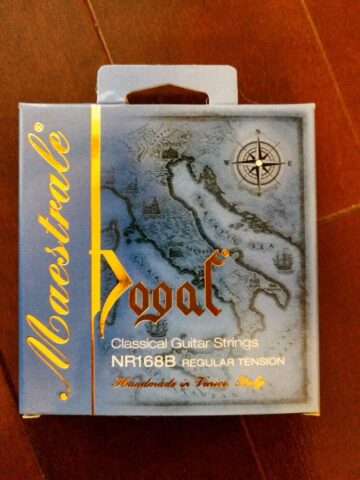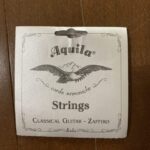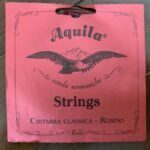This may be the most unusual string I’ve ever used. They are called Sugar strings, recently released by Aquila. As the name suggests, the strings are made from sugar cane. It’s a string that looks and sounds quite impressive.

The following article summarizes the string reviews/impressions/information articles in this blog
You can also read more about Aquila strings here:.
- Treble strings made of plastic from sugar cane
- Bass strings with a resin-like coating instead of metal plating
- Never-before-seen packaging
- Treble strings with acoustic guitar-like tone and sustain
- Despite its appearance, the bass string is surprisingly simple
- Strings that have a strong impact on both sound and appearance.
Treble strings made of plastic from sugar cane
The first thing that makes this Sugar unique is that the treble strings are not made of nylon or fluorocarbon, but of a plastic made from sugar cane.
These so-called bioplastics are said to be more eco-friendly than those made from petroleum.
In addition, there are benefits for the classical guitar as well, with Aquila measuring a 24% increase in projection and 18% increase in sustain over fluorocarbon.
Fluorocarbon is also said to have more projection and sustain compared to nylon, so it is a material that goes above and beyond.
In fact, Sugar is not the first string to use sugar cane derived materials, Alchemia strings were also used. The Alchemia strings are made of sugar cane plastic mixed with a proprietary material called Aquila Nylgut (at least the latest ones. Aquila often changes the material under the same name…).
They stopped using 100% sugar cane because it didn’t sound too much like the sound of a classical guitar, but they launched Sugar from 100% sugar cane in response to user expectations.
Bass strings with a resin-like coating instead of metal plating
The 100% sugar cane origin alone is unusual, but even more so is the bass string of this Aquila.
Bass strings on guitars are usually made by plating a copper winding with silver or some other material. This method has been used for a long time, but Aquila decided that there was a better way, so they decided to coat the strings with a resin-like material.
Aquila is not the first to use this method, D’Addario’s Pro Arte EXP series also uses the same method.
The advantage is that the coating does not rust and lasts longer than metal plating, which rusts.
Also, the coating on the Pro Arte EXP was rather plain, but the Sugar bass strings were quite striking to look at. More on that later in the photos….
Never-before-seen packaging
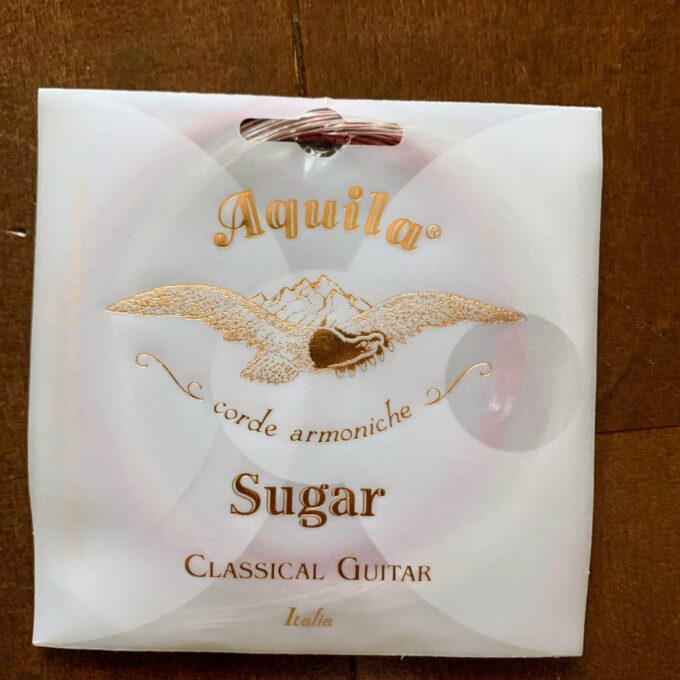
The picture above is the package. It may be because it is a new material string, the package also has a stylish design like never before. It is said that the package is eco-friendly, using as little paper and plastic as possible.

The back looks like this. If you think “Oh, the color of the strings…”, you are sharp.
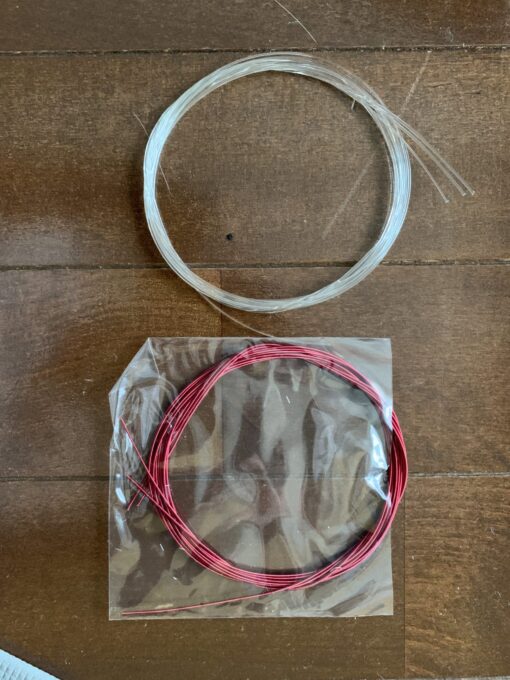
The bass strings are a red metallic color. The color does not look like a classical guitar at all.
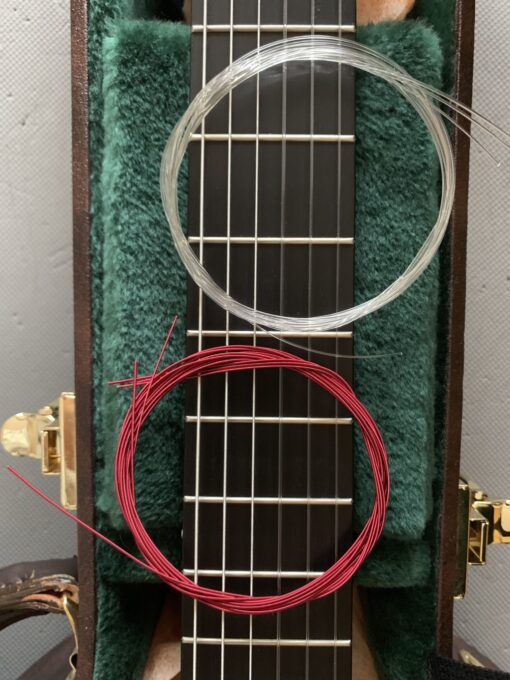
I compared it with normal strings. Needless to say, the impact of the red color of the bass string is too great.
The main thing is supposed to be the sugarcane derived plastic on the treble strings, but this one doesn’t look so different.
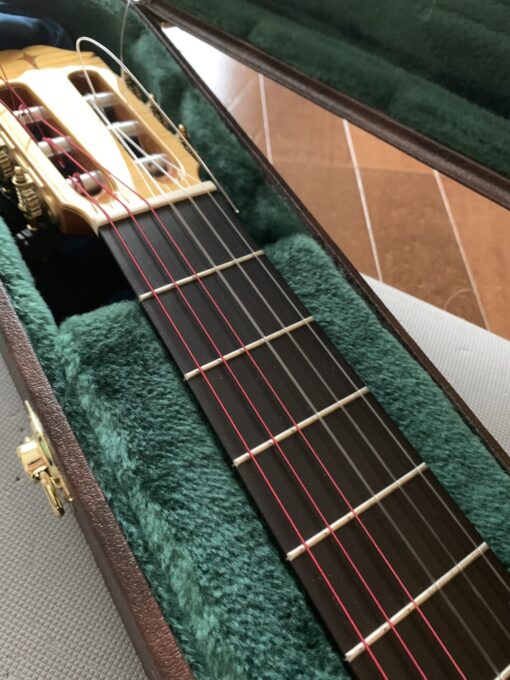
Here’s a picture of the guitar after it was strung. Hmmm, it doesn’t look like a crack guitar now.
Treble strings with acoustic guitar-like tone and sustain
No, the main point of a guitar is not the appearance but the sound, so this is a review of the sound.
The treble strings certainly have more volume and sustain than the fluorocarbon.
And it has a very bright tone. It’s too bright and metallic, and it sounds like you’re playing an acoustic guitar.
On the other hand, despite its volume and metallic sound, the tension is surprisingly low. At least, I don’t feel the strength of tension like carbon strings.
The surface of the string is easy to press down because the surface is also a little resistive to the touch.
On the other hand, there is one problem due to this resistance. This is officially acknowledged, but it makes a squeaking sound when it hits the skin of your finger. I actually put it out and recorded it :
It’s kind of an annoying sound, like styrofoam rubbing together.
In my case, I can’t get this sound unless I play it on purpose, but I heard that some people can get this sound even if they play normally.
(P.S.): The sound isn’t as overt as in the video above, but it can be a bit squeaky depending on how your right hand fingers hit it. Especially when I play with the meat of my thumb, this sound comes out, and sometimes it bothers me when I play pieces like Recuerdos de la Alhambra, where I play the treble strings with my thumb. It also squeaks a bit depending on how you hold down your left hand.
Aquila recommends applying a hand lotion to the fingertips and playing with it in this case. Also, the more you play, the more it will go away.
(P.S.): I’ve been playing it for about a week and it still sounds squeaky…
This treble string stretches very well. It is common that the string stretches for a while after it is strung, but this is the first time that it stretches so much while it is being strung. By the time I tuned it up, the string was stretched so much that it was wrapped around the winding like the picture below:
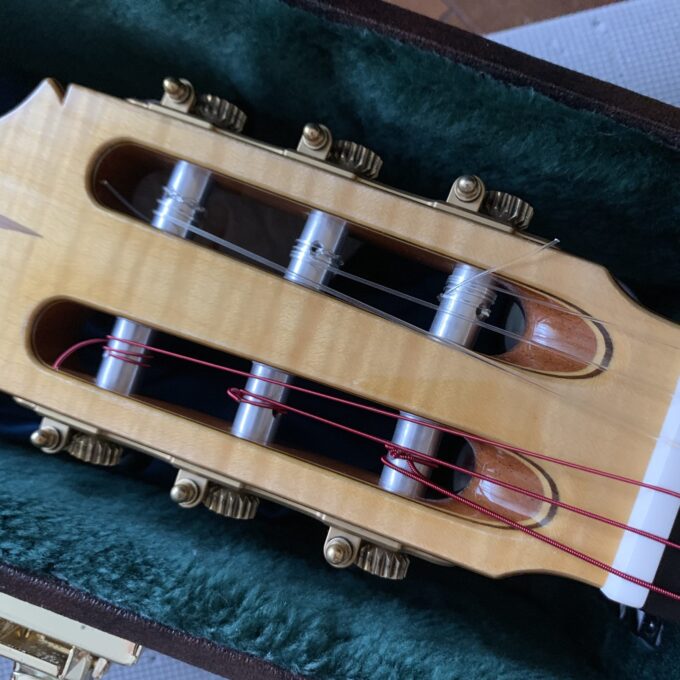
It is not stretched so much for playing after this, but I think this is the most stretching string ever.
(P.S.): The pitch stability is pretty good, for example, if you drop the 6th string to D, it will shift quite a bit while playing with normal strings, but this shift is small.
Despite its appearance, the bass string is surprisingly simple
The bass strings are red metallic color, so I thought it would be very flashy sound, but it is surprisingly simple sound.
I thought it would have a metallic sound, but it’s not, and it has a thick sound.
Of course the volume sounds as loud as the treble, and the sound separation is good, but it sounds quite legitimate compared to its appearance.
The other thing to check is durability. In my case, I play almost every day, so I don’t seem to be able to enjoy the advantage of reducing the deterioration caused by rust, but at least I hope they last longer than ordinary bass strings.
Strings that have a strong impact on both sound and appearance.
As you can see, the Aquila Sugars are some of the most distinctive strings I have ever used.
The sound and the appearance have an impact, so I think that people who are into it will be into it.
I feel like it’s especially suited for people who are going for an acoustic guitar kind of sound, or who like to play modern pieces.
On the other hand, if you prefer the round, soft, slightly dull sound of a traditional classical guitar, this is not for you at all.
If you’re a looker, it might be best to put this bass string and Dogal’s Maestrale treble string, lol.
Unfortunately, it’s not officially sold in Japan yet, but if you’re interested, you can buy it from an overseas retailer. I bought it from Strings by Mail:
Would I buy these strings again? I’m not sure. I’d like to add a note to this blog because my opinion may change as I use them again.
(Postscript): Finally, the red color of the bass string is peeling off, seems not stronger than the silver plating.

